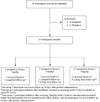Safety, tolerability, pharmacokinetics, and immunogenicity of the therapeutic monoclonal antibody mAb114 targeting Ebola virus glycoprotein (VRC 608): an open-label phase 1 study
- PMID: 30686586
- PMCID: PMC6436835
- DOI: 10.1016/S0140-6736(19)30036-4
Safety, tolerability, pharmacokinetics, and immunogenicity of the therapeutic monoclonal antibody mAb114 targeting Ebola virus glycoprotein (VRC 608): an open-label phase 1 study
Erratum in
-
Department of Error.Lancet. 2020 May 30;395(10238):1694. doi: 10.1016/S0140-6736(20)31195-8. Lancet. 2020. PMID: 32473676 No abstract available.
Abstract
Background: mAb114 is a single monoclonal antibody that targets the receptor-binding domain of Ebola virus glycoprotein, which prevents mortality in rhesus macaques treated after lethal challenge with Zaire ebolavirus. Here we present expedited data from VRC 608, a phase 1 study to evaluate mAb114 safety, tolerability, pharmacokinetics, and immunogenicity.
Methods: In this phase 1, dose-escalation study (VRC 608), conducted at the US National Institutes of Health (NIH) Clinical Center (Bethesda, MD, USA), healthy adults aged 18-60 years were sequentially enrolled into three mAb114 dose groups of 5 mg/kg, 25 mg/kg, and 50 mg/kg. The drug was given to participants intravenously over 30 min, and participants were followed for 24 weeks. Participants were only enrolled into increased dosing groups after interim safety assessments. Our primary endpoints were safety and tolerability, with pharmacokinetic and anti-drug antibody assessments as secondary endpoints. We assessed safety and tolerability in all participants who received study drug by monitoring clinical laboratory data and self-report and direct clinician assessment of prespecified infusion-site symptoms 3 days after infusion and systemic symptoms 7 days after infusion. Unsolicited adverse events were recorded for 28 days. Pharmacokinetic and anti-drug antibody assessments were completed in participants with at least 56 days of data. This trial is registered with ClinicalTrials.gov, number NCT03478891, and is active but no longer recruiting.
Findings: Between May 16, and Sept 27, 2018, 19 eligible individuals were enrolled. One (5%) participant was not infused because intravenous access was not adequate. Of 18 (95%) remaining participants, three (17%) were assigned to the 5 mg/kg group, five (28%) to the 25 mg/kg group, and ten (55%) to the 50 mg/kg group, each of whom received a single infusion of mAb114 at their assigned dose. All infusions were well tolerated and completed over 30-37 min with no infusion reactions or rate adjustments. All participants who received the study drug completed the safety assessment of local and systemic reactogenicity. No participants reported infusion-site symptoms. Systemic symptoms were all mild and present only in four (22%) of 18 participants across all dosing groups. No unsolicited adverse events occurred related to mAb114 and one serious adverse event occurred that was unrelated to mAb114. mAb114 has linear pharmacokinetics and a half-life of 24·2 days (standard error of measurement 0·2) with no evidence of anti-drug antibody development.
Interpretation: mAb114 was well tolerated, showed linear pharmacokinetics, and was easily and rapidly infused, making it an attractive and deployable option for treatment in outbreak settings.
Funding: Vaccine Research Center, US National Institute of Allergy and Infectious Diseases, and NIH.
Copyright © 2019 Elsevier Ltd. All rights reserved.
Conflict of interest statement
Declaration of Interests
NJS, JEL, and BSG are listed as inventors on pending patent applications for mAb114 which has been non-exclusively licensed. All other authors have no conflicts of interest.
Figures


Comment in
-
Ebola therapies: an unconventionally calculated risk.Lancet. 2019 Mar 2;393(10174):850-852. doi: 10.1016/S0140-6736(19)30160-6. Epub 2019 Jan 24. Lancet. 2019. PMID: 30686585 No abstract available.
References
-
- Sanchez A, Kiley MP, Holloway BP, Auperin DD. Sequence analysis of the Ebola virus genome: organization, genetic elements, and comparison with the genome of Marburg virus. Virus research 1993; 29(3): 215–40. - PubMed
-
- Ebola Virus Disease Fact Sheet: World Health Oganization, Febrary 12th, 2018.
-
- Geisbert TW, Jahrling PB. Exotic emerging viral diseases: progress and challenges. Nat Med 2004; 10(12 Suppl): S110–21. - PubMed
Publication types
MeSH terms
Substances
Associated data
Grants and funding
LinkOut - more resources
Full Text Sources
Other Literature Sources
Medical

